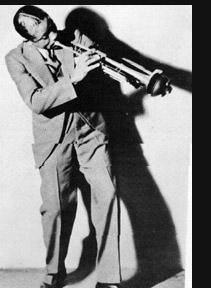Bubber Miley (James Wesley Miley)

Bubber Miley was born in Aiken, South Carolina, United States, into a musical family. At the age of six, he and his family moved to New York City where, as a child, he occasionally sang for money on the streets, and later, at the age of fourteen, studied to play the trombone and cornet. In 1920, after having served in the Navy for eighteen months, he joined a jazz formation named the Carolina Five, and remained a member for the next three years, playing small clubs and boat rides all around New York City. After leaving the band at the age of nineteen, Miley briefly toured the Southern States with a show titled The Sunny South, and then joined Mamie Smith’s Jazz Hounds, replacing trumpeter Johnny Dunn. They regularly performed in famous clubs around New York City and Chicago. While touring in Chicago, he heard King Oliver’s Creole Jazz Band playing and was captivated by Oliver’s use of mutes. Soon Miley found his own voice by combining the straight and plunger mute with a growling sound. Miley’s talent and unique style were soon noticed in New York’s jazz scene – among others by Duke Ellington who wanted him to jump in for trumpeter Arthur Whetsol. According to saxophonist Otto Hardwick, Ellington’s band members had to shanghai Bubber Miley into joining them for his first performance, at the Hollywood on Broadway in 1923, At the time, Ellington’s Washingtonians were formally led by Elmer Snowden, but Ellington, who factually had already been running the formation, also took over its official leadership a few months later.
Bubber Miley’s collaboration with Ellington in what later became The Duke Ellington Orchestra has secured his place in jazz history. Early Ellington hits, such as Black and Tan Fantasy, Doin’ the Voom Voom, East Saint Louis Toodle-oo (covered by Steely Dan in 1974 on their album Pretzel Logic), The Mooche, and Creole Love Call prominently feature Miley’s solo work and were thematically inspired by his melodic ideas, which he, in turn, often borrowed from Baptist hymns sung in his church, such as Stephen Adams’ Holy City. He and fellow band member, trombonist Joe “Tricky Sam” Nanton, created the “Wah-wah” sound that characterized Ellington’s early Jungle Music style. Many jazz critics consider Miley’s musical contributions to be integral to Ellington’s early success during the time they performed in the Kentucky Club and Cotton Club. In 1924, while working with Ellington, Miley also recorded Down In The Mouth Blues and Lenox Avenue Shuffle as a duo named The Texas Blue Destroyers, with Alvin Ray on reed organ. They managed to trick three different record companies into recording the same two songs, both composed by Ray. In interviews, former co-musicians such as Ellington, Nanton, Hardwick, and Harry Carney spoke fondly of Bubber Miley’s carefree character and joie de vivre, exemplified in numerous anecdotes. On the other hand, they also mention his notorious unreliability, and problems with alcohol abuse. Miley’s lifestyle eventually led to his breaking up with Ellington’s band in 1929, but his influence on the Duke Ellington Orchestra lasted far longer. His legacy lived on in trumpeters such as Cootie Williams and later Ray Nance, who both were able to adopt Miley’s style in their own way when needed.
After leaving Ellington’s orchestra in 1929, Bubber Miley joined Noble Sissle’s Orchestra for a one-month tour to Paris. After returning to New York, he recorded with a wide variety of recording groups led by King Oliver, Jelly Roll Morton, Hoagy Carmichael, Zutty Singleton and with Leo Reisman’s society dance band. Miley also performed live with Reisman, albeit being the only African American in Reisman’s all-white formation, either dressed in an usher’s uniform and off the bandstand, or hidden from view by a screen. In 1930, he recorded six songs for Victor Records under the name Bubber Miley and his Mileage Makers, a formation of thirteen musicians including clarinetist Buster Bailey. Miley’s health suffered from his problems with alcoholism. On May 20, 1932, at the age of 29, he died of tuberculosis on Welfare Island, now Roosevelt Island, in New York City. Miley lived just a little longer than his contemporary, jazz cornetist Bix Beiderbecke, whose life was also cut short due to alcohol abuse.
Born
- April, 03, 1903
- USA
- Aiken, South Carolina
Died
- May, 20, 1932
- USA
- Welfare Island, New York
Cause of Death
- tuberculosis


